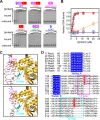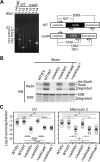The Lon protease-like domain in the bacterial RecA paralog RadA is required for DNA binding and repair
- PMID: 28432121
- PMCID: PMC5465501
- DOI: 10.1074/jbc.M116.770180
The Lon protease-like domain in the bacterial RecA paralog RadA is required for DNA binding and repair
Abstract
Homologous recombination (HR) plays an essential role in the maintenance of genome integrity. RecA/Rad51 paralogs have been recognized as an important factor of HR. Among them, only one bacterial RecA/Rad51 paralog, RadA, is involved in HR as an accessory factor of RecA recombinase. RadA has a unique Lon protease-like domain (LonC) at its C terminus, in addition to a RecA-like ATPase domain. Unlike Lon protease, RadA's LonC domain does not show protease activity but is still essential for RadA-mediated DNA repair. Reconciling these two facts has been difficult because RadA's tertiary structure and molecular function are unknown. Here, we describe the hexameric ring structure of RadA's LonC domain, as determined by X-ray crystallography. The structure revealed the two positively charged regions unique to the LonC domain of RadA are located at the intersubunit cleft and the central hole of a hexameric ring. Surprisingly, a functional domain analysis demonstrated the LonC domain of RadA binds DNA, with site-directed mutagenesis showing that the two positively charged regions are critical for this DNA-binding activity. Interestingly, only the intersubunit cleft was required for the DNA-dependent stimulation of ATPase activity of RadA, and at least the central hole was essential for DNA repair function. Our data provide the structural and functional features of the LonC domain and their function in RadA-mediated DNA repair.
Keywords: DN-binding protein; DNA repair; Lon protease; RadA; RecA; Thermus thermophilus HB8; X-ray crystallography; homologous recombination; site-directed mutagenesis.
© 2017 by The American Society for Biochemistry and Molecular Biology, Inc.
Conflict of interest statement
The authors declare that they have no conflicts of interest with the contents of this article.
Figures






References
-
- Cromie G. A., Connelly J. C., and Leach D. R. (2001) Recombination at double-strand breaks and DNA ends: conserved mechanisms from phage to humans. Mol. Cell 8, 1163–1174 - PubMed
-
- Shin D. S., Chahwan C., Huffman J. L., and Tainer J. A. (2004) Structure and function of the double-strand break repair machinery. DNA Repair 3, 863–873 - PubMed
-
- West S. C. (2003) Molecular views of recombination proteins and their control. Nat. Rev. Mol. Cell Biol. 4, 435–445 - PubMed
-
- Brigulla M., and Wackernagel W. (2010) Molecular aspects of gene transfer and foreign DNA acquisition in prokaryotes with regard to safety issues. Appl. Microbiol. Biotechnol. 86, 1027–1041 - PubMed
MeSH terms
Substances
Associated data
- Actions
- Actions
- Actions
- Actions
LinkOut - more resources
Full Text Sources
Other Literature Sources
Research Materials

